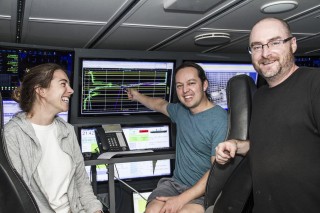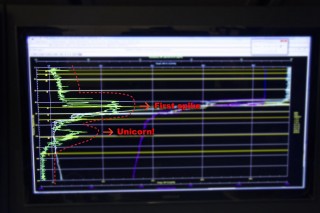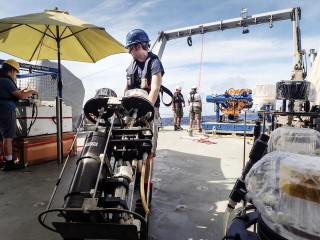
It was a magical feeling when the image appeared on the screens. The researchers in the Science Control Room were beyond excited: “This is just like finding a unicorn. You hear about them, some people even believe they exist, but you never expect to come across one,” said Dr. Mak Saito, chief scientist.
This particular unicorn has a name: Prochlorococcus. It is actually the most abundant photosynthetic organism in the planet, on which 10-20% of all photosynthesis depends (and yet it was only discovered in 1988, which goes to show how many mysteries the ocean still has in store for us). So if this phytoplankton is so abundant, why did some of the scientists break into a celebratory dance when the CTD rosette confirmed its presence?
Location, Location, Location

Most of the time, finding prochlorococcus is not a big deal. Not even here in the middle of the “desert,” which is how some scientists describe this particular (mostly-lifeless) area of the ocean. Researchers have always expected to find Prochlorococcus in the upper layers of the water, where there is light that they use to produce oxygen and fix carbon.
This CTD cast showed something different though: the green lights that indicate the abundance of chlorophyll (phytoplankton, that is) showed a clear spike at an expected depth. But then, some 155 meters below the surface, there was a second spike. The surprise is that this new population appeared where light is practically non-existent and oxygen is nowhere to be found. It “should not” be there.
Ideas and Theories

And so the second spike has become nicknamed The Unicorn. The next day, a new CTD cast at a different station shows the same phenomenon. What now?
Debate is ignited: are the organisms surviving at this depth since there are no predators in anoxic environments? If there is no there is no oxygen for predators to breathe, they can’t stay in the area long periods of time. Is it possible that the superficial water layer in which the phytoplankton originally lived simply sank, dragging this population with it? Are they actually creating oxygen from the tiny amounts of light that sometimes reaches this depth, but we don’t see the O2 because it gets consumed rapidly by other organisms?
A priority in these questions: are they even living? For the CTD to spot their chlorophyll, the organisms do not need to be alive. So after the team carefully parks a bottle right where they sit and extracts around 600 liters of seawater, they take samples. The scientists will conduct a series of experiments to determine if the prochlorococcus are metabolically active, transforming chemical compounds into mass. In other words, to see if they are alive and growing.
Once they know that, tests will show if their genome and proteome is different from that of the phytoplankton that lives higher on the water column. Have they adapted to low light conditions?
Eric Webb, environmental microbiologist, is having a blast. Trying to solve the enigma is fun enough, but if they actually found that these tiny organisms are alive and have evolved to live in these conditions… well, that would be remarkable.

